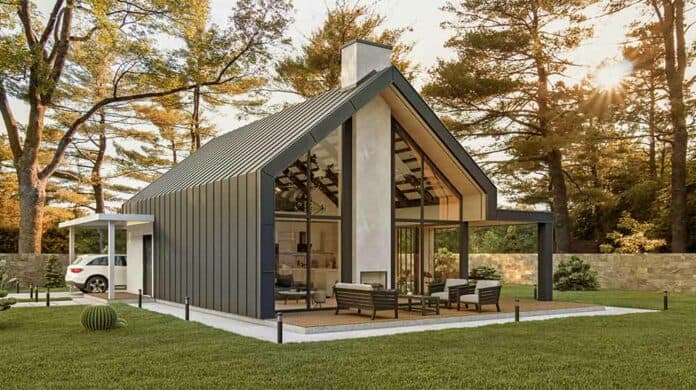Core Principles of Light Steel Frame Systems
When you’re thinking about light steel frame systems, it’s important to get a handle on what sets them apart. Their unique features, especially compared to old-school methods, really come down to strength and durability.
Knowing these basics can help you make better choices for your next construction project.
Key Characteristics and Definitions
Light steel framing uses thin sheets of steel, often called light gauge steel. This approach creates a structure that’s both strong and surprisingly lightweight.
-
Rapid Construction: Most components are prefabricated off-site, so assembly on location is fast.
-
Span Capabilities: You get bigger open spaces with fewer supports, which is great for design flexibility.
-
Recyclability: Steel is fully recyclable, making this a greener choice.
Comparison With Traditional Framing Methods
When you stack light steel framing against traditional wood, some differences jump out right away. For starters:
-
Strength: Steel’s way stronger than wood, so it can handle more weight.
-
Durability: It doesn’t get eaten by pests or rot, and it won’t warp with time.
-
Fire Resistance: Steel doesn’t burn, which is a big plus for safety.
Wood, on the other hand, often needs more maintenance and isn’t as eco-friendly since it relies on trees.
Strength and Durability Factors
One thing that stands out with light steel frame systems is their strength, thanks to cold-formed steel. These structures handle tough weather better than a lot of other materials.
-
Light steel frames are designed to resist bending and buckling.
-
They’re solid choices for seismic zones and places with strong winds.
Materials and Structural Components
If you’re building with light steel frame systems, you’ll want to know what materials and parts are actually involved. It’s all about cold-formed steel, the main components like studs and beams, and the benefits of galvanized steel.
Cold-Formed Steel Basics
Cold-formed steel is made by shaping steel sheets at room temperature. This process gives you thin, lightweight sections that are still tough.
Usually, you’ll see roll-forming used to make C and U shaped profiles. These shapes keep things stable but don’t weigh much. Cold-formed steel doesn’t warp, so it’s a favorite for modern builds.
Light Gauge Steel Components
Light gauge steel parts are key to a building’s framework. These include different steel sections that form the skeleton.
Studs are the vertical pieces that hold up walls, spaced about 16 or 24 inches apart. Tracks run horizontally and keep the studs lined up. Together, they make a frame that’s strong but not heavy.
Studs, Beams, and Trusses Explained
Studs, beams, and trusses are the backbone of light steel framing. Studs go up and down, while beams run across and help carry loads over openings.
Trusses are those triangular structures that spread out weight and give roofs extra support. They get the job done with less material but still keep things rigid.
Galvanized and Structural Steel Applications
Galvanized steel pops up a lot in these systems because it resists rust. The steel’s coated with zinc, which helps it stand up to moisture and corrosion.
You’ll see galvanized steel used where humidity or weather is a concern—so, pretty much everywhere. It’s tough enough for both homes and bigger commercial projects. If you need to go even bigger, structural steel steps in for the heavy lifting.
Design, Engineering, and Technology Integration
For light steel frame systems (LSF), the magic happens when design, engineering, and tech all come together. It’s a mix of creative ideas, careful calculations, and some pretty slick software.
Architectural and Engineering Considerations
When you’re planning an LSF project, architects and engineers have to work hand in hand. You’ve got to think about structural integrity and make sure you’re following local building codes.
Because LSF is lightweight, you can get those tall, open designs without worrying about strength. Engineers crunch the numbers for loads and connections so everything stays safe.
Design Flexibility and Customization
One of the best things about LSF is how flexible it is. Compared to old-fashioned building methods, you can tweak layouts without much hassle.
It’s easy to adapt your plans if something changes. Whether you’re working on a house or a shop, you can shape the space to fit your needs and still keep things sturdy.
Building Information Modeling (BIM) and Design Software
BIM technology has really changed the game. You can model every part of the building before you even start construction.
With BIM, you get a clear picture of the whole project and can spot problems early. Tools like Tekla Structures help manage the details and keep everything connected.
It’s easier to work with your team and make changes as you go. That means fewer surprises, better communication, and usually a faster, less expensive build.
Construction Process and Methods
Building with light steel frame systems comes down to a few key steps: prefabrication, on-site assembly, and keeping an eye on quality. Each one matters for a smooth project.
Prefabrication and Manufacturing
Prefabrication is a big deal here. Components are made off-site, usually in a factory, where things are more controlled.
Most of the time, it’s cold-formed steel framing that gets used, since it’s light but strong. Digital design tools help make sure the parts are accurate, and less material gets wasted.
Panels and frames are pre-made so that when they show up at the site, they fit together quickly. That means less waiting around and fewer headaches.
On-Site Assembly Procedures
After delivery, the real action starts on-site. First, the site gets prepped for the frames. Builders use cranes and other gear to put each piece in place.
Most connections are bolted because it’s quick and reliable. If something doesn’t line up, it’s easier to adjust on the fly. Safety’s a big deal here—proper training and gear keep things running smoothly.
Quality Control and Code Compliance
Quality control is a must from start to finish. Factories stick to strict standards, which helps make sure everything is safe and solid.
Builders need to know the local codes inside and out. Regular inspections during assembly help catch problems early, so you end up with a compliant, safe building.
Applications in Residential and Commercial Projects
Light steel frame systems are picking up steam in both homes and commercial buildings. Their speed, strength, and adaptability make them appealing for all sorts of projects.
Residential Homes and Buildings
You’ll see light steel frames in single-family homes, townhouses, and duplexes. They give you solid support without a ton of weight.
Design flexibility is a big win here—you can have open living spaces with fewer walls. Plus, the build goes faster, so you’re not waiting forever to move in.
Commercial and Mid-Rise Building Uses
For commercial spaces and mid-rise buildings, light steel frame systems really shine. They’re tough enough for several stories and keep everything stable.
Faster construction means businesses can get up and running sooner. And since steel is recyclable, it’s easier to hit those sustainability goals.
Lots of companies use light steel frames for schools and healthcare buildings, where safety and durability really matter.
Adaptability for Specialized Facilities
These systems aren’t just for houses and offices. You can use them for warehouses, labs, even hospitals.
They’re built to handle rough weather, which is a huge plus in challenging locations. Prefab parts make on-site assembly quick, and if you need to tweak the layout, it’s not a big deal.
Advantages and Performance Benefits
Light steel frame systems bring a lot to the table. You get sustainability, less maintenance, and cost efficiency—pretty compelling stuff for any project.
Sustainability and Environmental Impact
Going with light steel framing can help you build greener. Steel often comes from recycled sources, so the footprint is smaller.
When a building’s done, the steel can be recycled again. Plus, many systems are designed to meet green building standards, which is great if you care about the environment.
Maintenance and Longevity
Maintenance is where steel really outshines wood. No warping, no rot, and you don’t have to worry about termites eating your investment.
Steel frames stick around for decades, so you’re not stuck fixing things all the time. The upfront cost tends to pay off since you’ll spend less on repairs over the years.
Cost Efficiency and Energy Performance
Light steel frames can be a smart choice economically. Sure, the upfront price might be a bit steeper than wood, but that doesn’t always tell the whole story.
Over time, their durability means fewer repairs and less hassle about replacements. That kind of reliability is hard to ignore.
These systems also tend to fit right in with energy-efficient designs. Steel frames hold up insulation really well, making it easier to keep a building comfortable year-round.
Less energy wasted on heating and cooling? That’s good news for your bills—and, honestly, for the planet too.



















